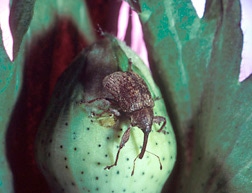
Tracking the boll weevil’s itinerary
A diverse team of U.S. Department of Agriculture (USDA) scientists has helped cotton growers track down the likely origins of a boll weevil infestation, provided guidance on how to avoid future infestations and shed light on how far the pest can travel under certain conditions.
January 27, 2011

A diverse team of U.S. Department of Agriculture (USDA) scientists has helped Texas cotton growers track down the likely origins of a boll weevil infestation, provided guidance on how to avoid future infestations and shed light on how far the pest can travel under certain conditions.
Researchers with the USDA's Agricultural Research Service (ARS) went to work after thousands of boll weevils turned up in monitoring traps in 2007 in parts of Texas' Southern Rolling Plains where the insect had been all but eradicated. ARS is USDA's principal intramural scientific research agency, and the research supports the USDA goal of promoting agricultural sustainability.
The boll weevil was eliminated from much of the southern United States, thanks to large-scale eradication efforts begun about 30 years ago, but it remains a problem in some areas, and reinfestations are a constant threat. Growers in the area affected in the 2007 infestation spent $1.4 million in increased insecticide applications alone.
The ARS research team included Thomas Sappington, an entomologist at the agency's Corn Insects and Crop Genetics Research Unit in Ames, Iowa and an expert at using DNA to identify insect populations; John Westbrook, a meteorologist with the agency's Southern Plains Agricultural Research Center (SPARC) in College Station, Texas, who can use modeling techniques and weather data to analyze the effects of wind patterns on insect movement; and Gretchen Jones, a palynologist also based at SPARC who can often identify an insect's itinerary by the type of pollen grains it picks up.
The researchers had one clue. Tropical Storm Erin had swept through South Texas in August 2007, passing 112 miles to the south near Uvalde in an area known as the Winter Garden District. Between Uvalde and the infested region is the Texas Hill Country, an arid region of scrubby vegetation with plants that produce types of pollen not found among the captured weevils. Based on their multi-faceted data, the researchers concluded that the storm brought weevils into the area from the Winter Garden district.
The results, published in the Journal of the Royal Society Interface, prompted growers to target the Winter Garden District for stepped-up eradication efforts. The findings also provided guidance on when approaching storms and hurricanes may warrant early harvests to prevent reinfestations.
Read more about this research in the January 2011 issue of Agricultural Research magazine.
You May Also Like



